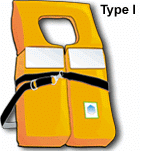 Type I PFDs, or offshore lifejackets, are the most buoyant PFDs and suitable for all water conditions, including rough or isolated water where rescue may be delayed. Although bulky in comparison to Type II and III PFDs, offshore jackets will turn most unconscious individuals to the face-up position. They range in sizes from adult to child.
Type I PFDs, or offshore lifejackets, are the most buoyant PFDs and suitable for all water conditions, including rough or isolated water where rescue may be delayed. Although bulky in comparison to Type II and III PFDs, offshore jackets will turn most unconscious individuals to the face-up position. They range in sizes from adult to child.
 Type II kids vest is designed for comfort. Type II PFDs, or near-shore buoyancy vests, are for calm and open water where a rescue will occur quickly. They are not designed for long periods in rough water. These vests will turn some, but not all, unconscious wearers face-up in the water. Some inflatable Type II models will turn wearers to the face-up position as well as a Type I PFD. This vest is less bulky than a Type I and often the least expensive of the PFD types. Type II PFDs are available in a variety of sizes.
Type II kids vest is designed for comfort. Type II PFDs, or near-shore buoyancy vests, are for calm and open water where a rescue will occur quickly. They are not designed for long periods in rough water. These vests will turn some, but not all, unconscious wearers face-up in the water. Some inflatable Type II models will turn wearers to the face-up position as well as a Type I PFD. This vest is less bulky than a Type I and often the least expensive of the PFD types. Type II PFDs are available in a variety of sizes.
 Type III Water Sport Vest with impact rating of 100MPH. Type III PFDs, or flotation aids, are for calm and open water where a rescue will likely occur quickly. These PFDs are designed to keep the wearer in a vertical position. It is the wearer’s responsibility to maneuver themselves into a face-up position, usually accomplished by tilting their head back. Type III inflatable models will keep unconscious wearers face-up as well as a Type II inherently buoyant vest. This PFD is not recommended for rough water conditions. These PFDs are the most comfortable to wear and popular for recreation boating and fishing. Type III PFDs come in various sizes from adult to child.
Type III Water Sport Vest with impact rating of 100MPH. Type III PFDs, or flotation aids, are for calm and open water where a rescue will likely occur quickly. These PFDs are designed to keep the wearer in a vertical position. It is the wearer’s responsibility to maneuver themselves into a face-up position, usually accomplished by tilting their head back. Type III inflatable models will keep unconscious wearers face-up as well as a Type II inherently buoyant vest. This PFD is not recommended for rough water conditions. These PFDs are the most comfortable to wear and popular for recreation boating and fishing. Type III PFDs come in various sizes from adult to child.
Support FOK
Friends of the Kaw welcomes monetary donations of any size. These funds are used to support our educational activities and help us protect the Kaw.
Chasing the Channel blog
Paddle Resources
 Paddle safely! Use the links below to quickly access information that impacts river conditions.
Paddle safely! Use the links below to quickly access information that impacts river conditions.
Friends of the Kaw recommends 5,000 cfs or lower for novice paddlers and 8,000 or lower for all paddlers. Above 8,000 cfs there are virtually no sand bars for rest stops
Report Pollution
Help us to fight pollution on the Kaw. Report events or activities on or near the river that could negatively impact water quality.
To view the complete calendar, click here.
Newsletter
Sign up to receive email newsletters and stay up to date on what's happening with the river!
Click here to view archived newsletters.
Copyright © 2025 · Genesis Framework · WordPress · Log in


